Disclaimer: There are many states and weaves that have not been included. This article was literally written overnight with a few volunteers who shared pictures. I hope to do a state-wise weave list. This article is merely to highlight #Vocalforlocal and #SustainableFashion. Please also refrain from downloading pictures from the article. Thank you.
Greetings on National Handloom Day!
It was on August 7th, 1905 that Aurobindo Ghosh, Bal Gangadhar Tilak, Bipin Chandra Pal, Lala Lajpat Rai and several others started a Swadeshi Movement asking Indians to boycott all British products. A Boycott Resolution was passed in Calcutta City Hall on August 7, 1905, where it was decided to boycott the use of Manchester cloth and salt from Liverpool. In the district of Barisal, the masses adopted this message of boycott of foreign-made goods, and the value of the British cloth sold there fell sharply. The movement had aimed at reviving domestic products and production processes.
The first National Handloom day was observed on August 7th, 2015, when the Union government aimed at generating awareness about the rich handloom industry of India. India is home to a staggering 95% of the world’s handlooms, and hand-weaving is the largest employer in the country after agriculture.
Handloom weavers have since long brought to us the legacy and richness and diversity of our culture. However, over the years many weaving traditions have taken a hit due to various reasons. For one the advent of power-loom and synthetic textiles gave the population cheaper textiles. The last few years has also seen policies where the weavers have been battling several constraints. To read more you could go to a previous guest blog.
In this article, I would like to share a compendium of beautiful weaves. These are but a few of the hundreds of weaves and techniques that are part of the Indian heritage. If we do not encourage our weavers, these techniques will be lost forever. The weaves are not mere garments but a huge part of our legacy and heritage.
I hope you like this collection and make it part of your wardrobe. This is by no means an exhaustive collection of weaves and there is so much to write on the technicalities that an article like this will never do justice. However, it is just a small attempt in commemorating the day and I thank all the ladies who sent in their pictures and contributed to this article.
Ponduru Khadi: Let’s start with Ponduru Khadi. The khadi woven here caught the attention of Mahatma Gandhi himself, who visited visited the village of Ponduru and opted to wear this Khadi. Ponduru, also called the Khadi village, is situated 30 km away from Srikakulum district of Andhra Pradesh. This is one of the only places where the single spindle charkha is still used for spinning. The Khadi produced in this village has its own Geographical Identification (GI) tag. Says Anusha Parthasarthy, an IT professional and a mother of two young children ” I am fiercely loyal to anything which is Pro Nation. I am vociferous to anything which is anti-Indian.That’s why my choice for the Handloom Day is Ponduru Khadi.”

Ajrakh Saree: Ajrak is a block-printed textile technique that is resist-dyed using natural dyes that include indigo and madder. It has its origins in Kutch, Gujarat and is distinguished by its color- blue with red — and its complex geometric & floral patterns. It’s name is derived from ‘azarak’, ‘blue’ in Arabic & Persian. There are between 14–16 different stages of dyeing & printing, which take 14–21 days to complete. Says Simi Mehta,” The feeling of being able to wear a priceless piece of heritage that boasts of one of the earliest block printing technique in the world that involves as many as 14 complicated steps, is beyond words! Ajarakh; the beautiful piece of art that carries forward centuries of history from the rugged land and its culture has great aesthetic appeal. Be it my work meetings, social gatherings, festivals, or celebration I usually tend to look for one of my Ajarakh saris.”

Ashavali: Ashavali is a brocade weave. The work however is called meenakari.
weavers from Ashavali moved to Benaras to create the now-famous Benarasi brocades. Ashavali’s motifs are floral and rich in colour. Indeed, Ahmedabad once used to be called Ashavali. The name Ashavali comes from Ashapalli, which was named after a Bhil king called Asha Bhil.
Weaving here goes back to the 8th century. Motifs were drawing from the Mughal aesthetic. Common motifs are paisley, birds, flowering vines, animals and humans. The motifs were made with bright, enamelled contrast colours and called minakari work. The motifs appear to float on the saree because they are woven using the alternating twill technique.

Bhujodi: The Bhujodi village is a 500 year old village in the Rann of Kutch. The saree designed and woven by Kutchi shawl weavers is a favourite with many women just like the model and energy-healer, Sameera Kamulkar. The Bhujodi shawls are famous and the weavers then extended it into weaving sarees as it gave them income all year round. The craft is said to have evolved when the barter system was practiced as a method of exchange of items. The ‘Rabaris’ being the original nomads and cattle rearers provided wool, milk products and grains to the village and ‘Vankars’ took up to weaving cloth. While rearing cattle pretty much remained the same, the Vankars developed their weaving techniques and excelled over the years.
Chettinad Saree: Chettinad cotton sarees are woven by Devanga Chettiyars, who are the skilled weavers since ancient days. The light weight cotton fabric of has a shimmery look, with contrasting borders, and wonderful motifs that brings an elegance to the wearer. The quality of the saree will also last a long time and easy maintenance, making it one of the most desired for regular work wear.
Says Gayatri Rajashekhar, who is in a Chettinad saree here, “Chettinad saree is one of my favourite sarees, as I love the way it drapes and stays put for whole day whether it training, conference, site visit and client meeting. The vibrant colourful palette of Chettinad is amazing which mesmerises me and it lifts the spirits whenever worn. This beautiful Chettinad saree in the picture is a bright sindoor red with golden beige broad border. Border has beautiful golden beige peacock motifs.”
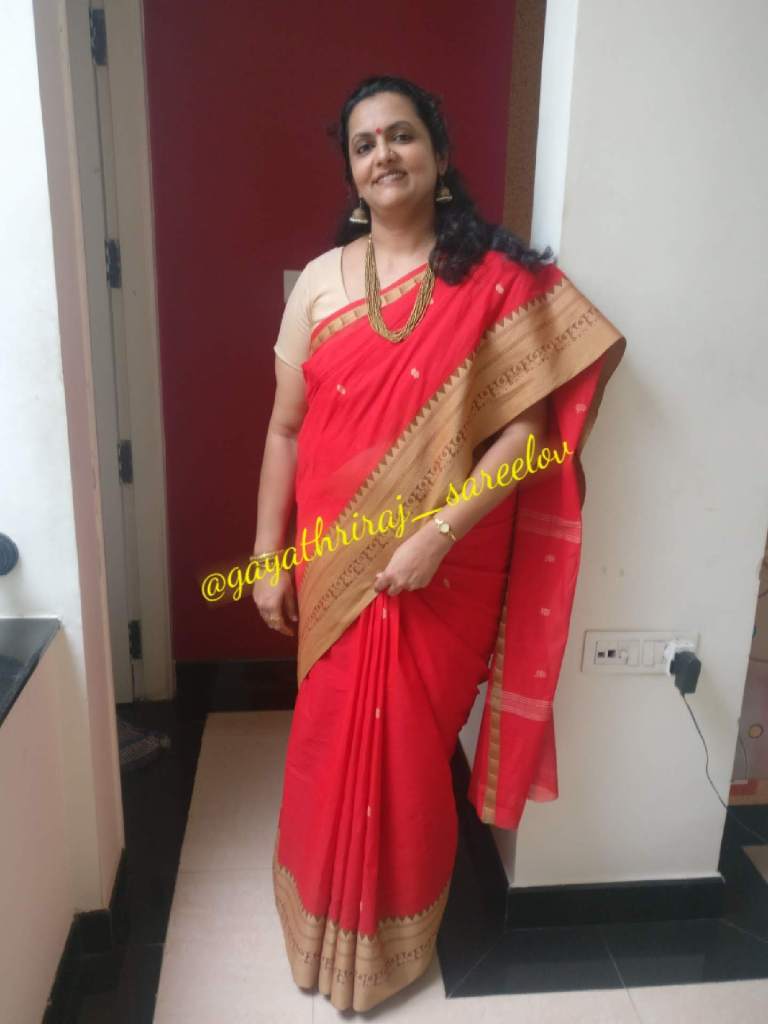
Banarasi Saree: Who wouldn’t want a Banarasi saree in their wardrobe or trousseau? Benarasi SIlk, is a fine variant of Silk , originating from the ancient city of Varanasi. Sarees woven from this fine silk, known as a Benarasi Silk Sarees are extremely popular all over India and across the world.
With a mention in the Mahabharata and in the Buddhist scriptures in the first millennium, Benarasi silk have their roots seeped into the rich cultural history of India.
Originally crafted exclusively for the royalty, each Benarasi saree was created from real gold and silver threads, taking as much as an year to make. In 2009, after two years of wait, weaver associations in Uttar Pradesh, secured Geographical Indication (GI) rights for the ‘Banaras Brocades and saris’. As per the GI certificate, Banarasi products fall under four classes (23–26), namely silk brocades, textile goods, silk sari, dress material and silk embroidery. Most importantly this means that no sari or brocade made outside the six identified districts of Uttar Pradesh that is Varanasi, Mirzapur, Chandauli, Bhaohi, Jaunpur and Azamgarh districts, can be legally sold under the name of Banaras sari and brocade. In the present days, Banarasi silk sarees are still considered to be one of finest traditional sarees and are a part of every bride’s trousseau . It has actually been well known for its designing and gold as well as silver brocade or the ‘Zari‘.
Depending on the kind of weave and patterns, Banarasi sarees are categorised as tanchoi, jangla, Banaras tissue, Banaras organza, vaskat, jamdani, mixed jamdani, kora cutwork, satin border, butidar and so on.
The Covid-19 pandemic and the lock-down has affected the weavers so much that they have resorted to sell vegetables. Here Vaishali Joshi, Founder,’The V-Factor’, is wearing a pure kataan silk banarsi saree with a double border and boota inspired by the Mughal floral gardens.

Chanderi Sarees: The Chanderi katan silk worn by educationist Dr. Kavita Lohiya Bajpai, is a lustrous handloom saree from the town of Chanderi. Chanderi is a historical a town which has seen reigns from the Mughals to Bundelas. the city is also mentioned in the Mahabharata. A town which is the synonymous with tangible and non tangible heritage is today struggling to create a platform and the respect it deserves largely due to a dwindling market. The wages for the labour its artisans put in is hence not commensurate. Chanderi weave is as old as 7th century A D. but with the contemporary changes, improvisation in weaving style and new techniques also could not stop the weavers’ condition for further deterioration.

East Godavari Saree: There are 18,000 looms in East Godavari. A major section of weavers work under master-weavers. Says Reshmi Shankar, “I love the every day simplicity of the East Godavari weave. The colors are as bright and beautiful as they come and the ease of wear for a daily sari draping office goer is incomparable! Icing on the cake, it’s real easy on the pocket. “

Gadwal Sarees: Gadwal Sarees are beautifully handwoven, handcrafted sarees of the Telangana state of India. It was registered as one of the Geographical Identification (GI) tagged goods. They are light and compact and are usually rolled like a huge pancake to keep folded. The saree usually has a light handwoven cotton body with silk and zari woven into rich borders and pallu. The distinctive feature of Gadwal sarees is the pallu of the saree is joined later. So always look out for the kuttu stitches to spot an original.It’s a traditional saree that is used to adorn the Deity at Tirupati during the Brahmotsav.
Jamdani: Jamdani is a fine muslin textile produced for centuries in South Rupshi of Narayanganj district in Bangladesh. The historic production of jamdani was patronized by imperial warrants of the Mughal emperors. Under British colonialism, the Bengali jamdani and muslin industries rapidly declined due to colonial import policies favoring industrially manufactured textiles. In more recent years, the production of jamdani has witnessed a revival in Bangladesh. Jamdani is typically woven using a mixture of cotton and gold thread.
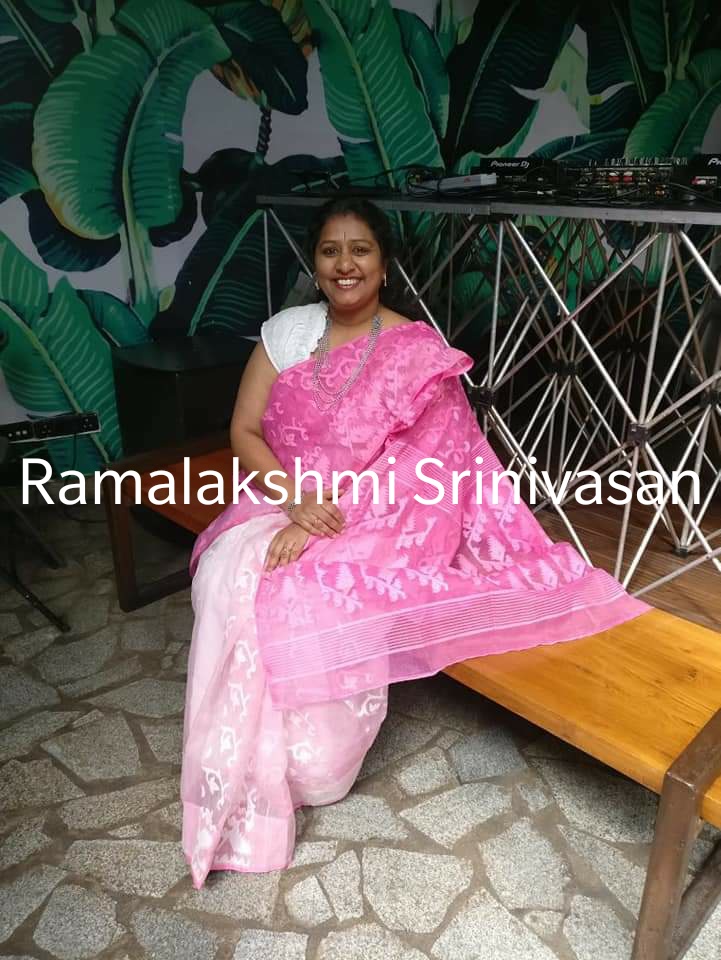
Kosa Tussar: Chandrapur, situated in the district of Janjgir-Champa in Chattisgarh, is the centre of the highly regarded Tussar – also known as Kosa – silk weaving and Kosa saree production. Majority of families in Chandrapur have been traditional weavers of Kosa silk sarees for generations, from the initial stage of collecting cocoons until the final stages of production and distribution. This Kosa saree with Gheecha pallu worn by Sunita Srinivasan reminds her of the beauty of the wilderness. ” The tussars fall in this category if you were to compare silks to beaches or verdant gardens,” she says.
Geecha or Khewa are the names given to yarns that are not dyed when Tussar silk is reeled. Ghicha threads are the undyed leftovers of pure Tussar silk threads which are processed for dying.
As the fabric is really raw, the comfort offered is unparalleled. This saree has both tussar and geecha in the form of vertical lines running through it.
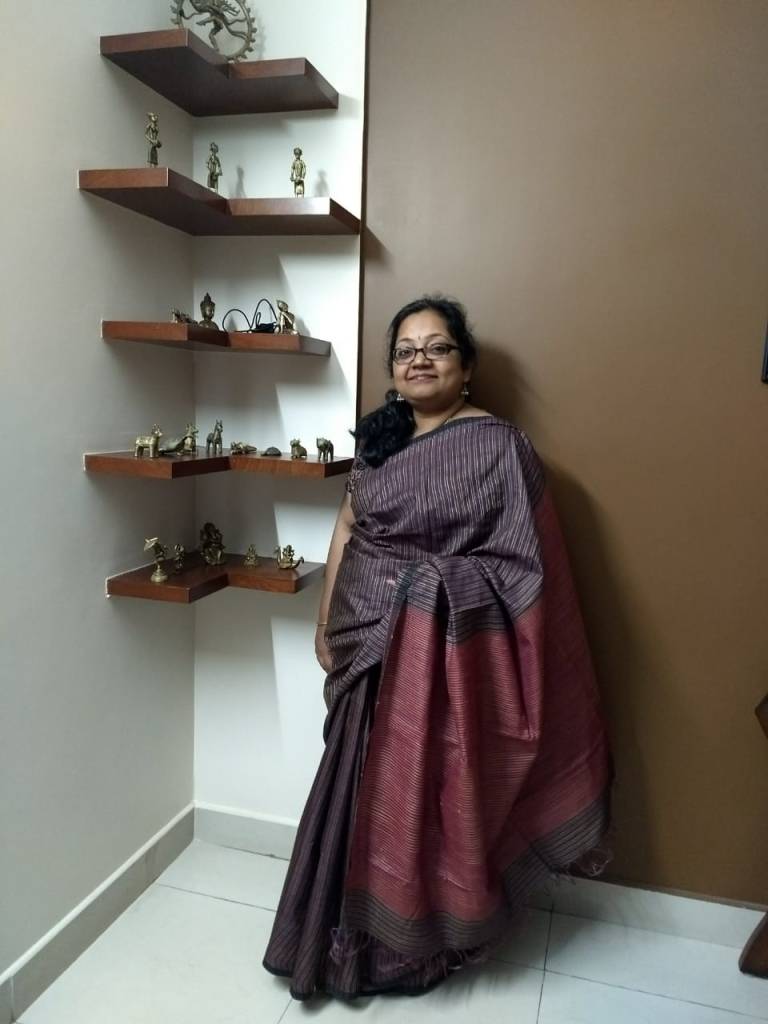
Koorainadu sarees: These are sarees that woven in and around Mayiladuthurai in Tamil Nadu and are a story in revival. For more details please click on anarticle that I wrote for Deccan Herald.

Kanchipuram Sarees: Some call it the King of weaves. It is believed that the Kanchi silk weavers are descendants of Sage Markanda, who was considered to be the master weaver for the Gods themselves. While cotton is considered to be the favourite fabric of Lord Shiva, silk was preferred by Lord Vishnu. It was during the reign of Krishna Devaraya (from the Vijayanagara Empire) that the art really took off. Two major weaving communities of Andhra Pradesh, the Devangas and Saligars migrated to the town of Kanchipuram. They used their excellent weaving skills to make the silk saree that bore images of scriptures and figurines found on the temples around the village.
Here Renuka Prakash wears her mother’s vintage handloom Kanchipuram silk saree.

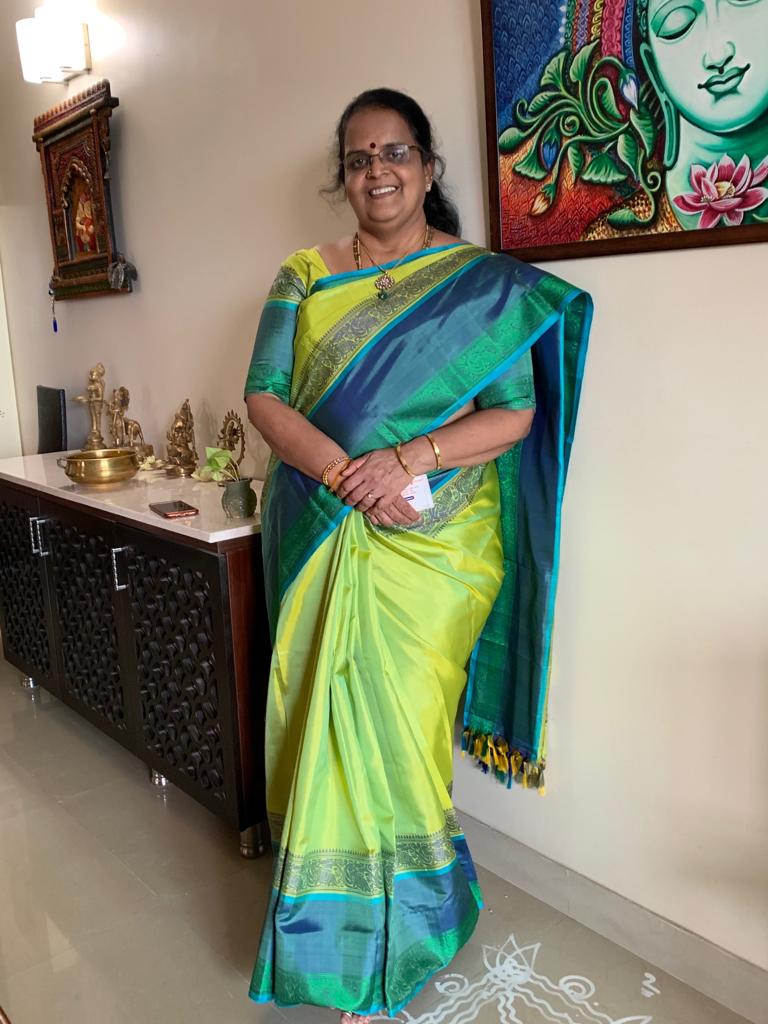
Mangalgiri: The Mangalagiri saree is woven from Guntur district of Andhra Pradesh . The name translates to “auspicious hill ” and these sarees are simple , yet very elegant. Made from pure cotton yarn, Mangalagiri fabric is known for its durability, softness and elegance. This is due to the fact that most of the materials are made up of 80*80 counts while few of them are of 60*40 count. The count here is a measure of the number of threads woven length (warp) and breadth wise(weft). Moreover, the fabric is woven tightly over pit looms with the weavers sitting at ground level with their feet firmly below the ground. This lends the fabric the soft texture and a characteristic sheen. Says Swetha Sundar, a writer and poet, “The fabrics are breathable, light on the skin and great for all climates including summer. Just as a mangalam is an integral part of a recital , a Mangalagiri is the most treasured weave in my wardrobe.” Another key feature of Mangalagiri sarees are their famous traditional zari borders, also known as Nizam borders that are about two inches thick.The sarees that are woven in bright hues have a thick gold border that has some very closely-knit patterns like tiny inverted checks. The zari in these hallmark borders is superimposed by weaving them over the regular weave unlike many handlooms where the zari itself is woven alone as the border. The body of the fabric has minute checks, stripes and devoid of any large woven patterns lending it a crisp, simple yet dignified look.
Molakalmuru Sarees: Molakalmuru is a town in Chitradurga district of Karnataka. It is famous for the unique Molkalmuru sarees which are woven here. Legend has it that its name means “broken knees” in Kannada after a battle between the native Indians and the British in which, due to the rocky and hilly terrain behind the city, the Brits suffered many broken knees in their losing battle. The last picture is the reverse of the saree where you can see how the deftly the pallu and border are attached to the body. Srilakshmi Dorairajulu, a software engineer, wears a gorgeous green Molkalmuru silk.


Odisha Weaves; Tussar 1000 buttis: Says saree influencer and entrepreneur Rohini Krishna, ” I have discovered a treasure trove of weaves in the state of Odisha. This particular saree, a tussar hazaar butti is my absolute favorite.” The saree with about 1000 motifs of tortoise and fish motifs woven in extra weft is pure understated elegance. Broad borders on either side have rows of rudraksh and fish with extra weft, fish and turtle in a row in the center of the border. The aanchal has ikat motifs of rangoli and animals again with rows of extra weft motifs. A saree that is pure magic in weaves.



Paithani:
Paithani is a variety of sari named after the Paithan town in Aurangabad, Maharashtra state where the saree was first handmade. Present day Yeola town in Nashika, Maharashtra is the largest manufacturer of Paithani. Made from very fine silk, it is considered as one of the most expensive saris in India. It is one of the most famous saris in India.It is also considered to be made from the finest silk in India. Purvi Sharma, in the picture is wearing is in silver zari with muniya Border Munia means parrot. Parrots are woven on border & has the traditional Maharashtrian nath motifs woven on the pallu.
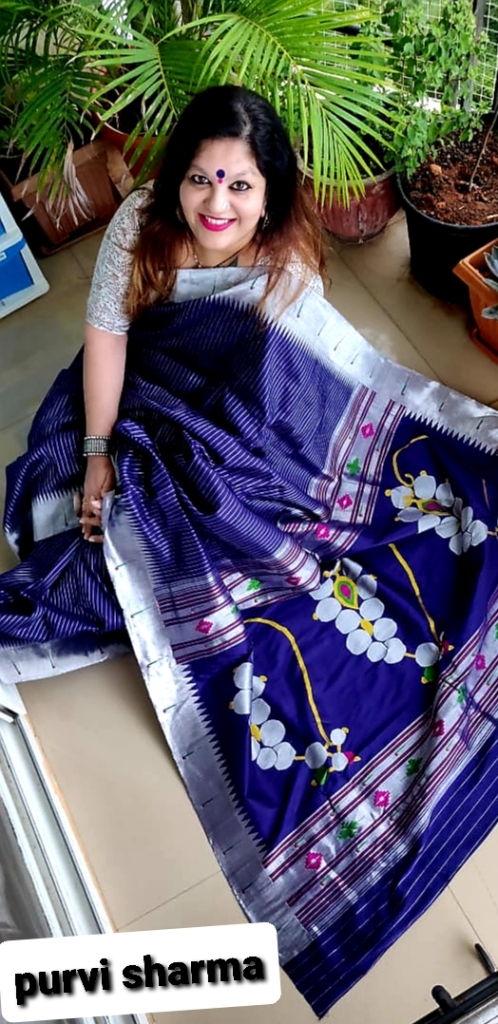
Pochampally: Manjula Gone is a native of Jangaon, a village in Telengana near Warangal where the Pochampally saree is also woven. She proudly flaunts the Pochampally Saree or Pochampalli Ikat. This saree originated in Bhoodan Pochampally, Yadadri Bhuvanagiri district in Telengana state. They have traditional geometric patterns in Ikat style of dyeing. The intricate geometric designs find their way into sarees and dress materials.

Siddipet Sarees – There are 3 types of Siddipet sarees.
1. Bathukamma saree – Bathukamma is a floral festival celebrated by the Hindu women of Telangana. Every year this festival coincides with Durga Navratri. It starts on the day of Mahalaya Amavasya and culminates on Durgashtami which is two days before Dussehra or Vijayadasami. History has it that the present Telangana region was ruled by Satyaasraya in 997 A D. In the erstwhile kingdom of Vemulavaada (present Karimnagar District), the Rajarajeswara temple was popular. Rajendra Chola, son of Raja Raja Chola, Chief of Army attacked and won over Satyaasraya. As a sign of his victory he destroyed Rajeswara’s temple and took the Bruhat (huge) Siva linga to his father as a gift. As an attempt to console Parvathi (Bruhadamma) in the temple here and to inform their grief to Cholas, practice of Bathukamma (derived from Bruhadamma) came into being. Bathukamma is a floral arrangement which represents Mount Meru. At the top, a symbolic version of Gouramma (Gouri or Parvathi) made with turmeric is placed and celebrated with songs in praise of mother Goddess Parvathi for nine days. Slowly this began to be celebrated as a festival. Women pray for good health, prosperity and happiness for their families.The Bathukamma sarees from Siddipet represent this ancient practice.
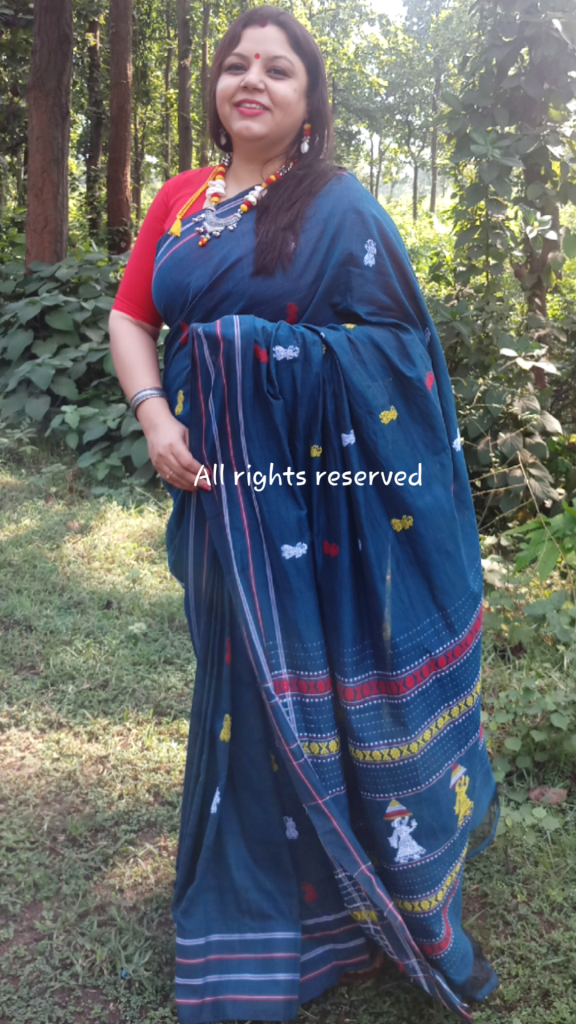
2. Gollabama Saree – Siddipet located in northern part of Telangana is also known for its handloom sarees called Gollabhama. Gollabhama translates to milkmaid and these sarees are called so due to the distinct motifs of milkmaids carrying their pot of milk which is woven all over the body and bigger motifs in the palla.
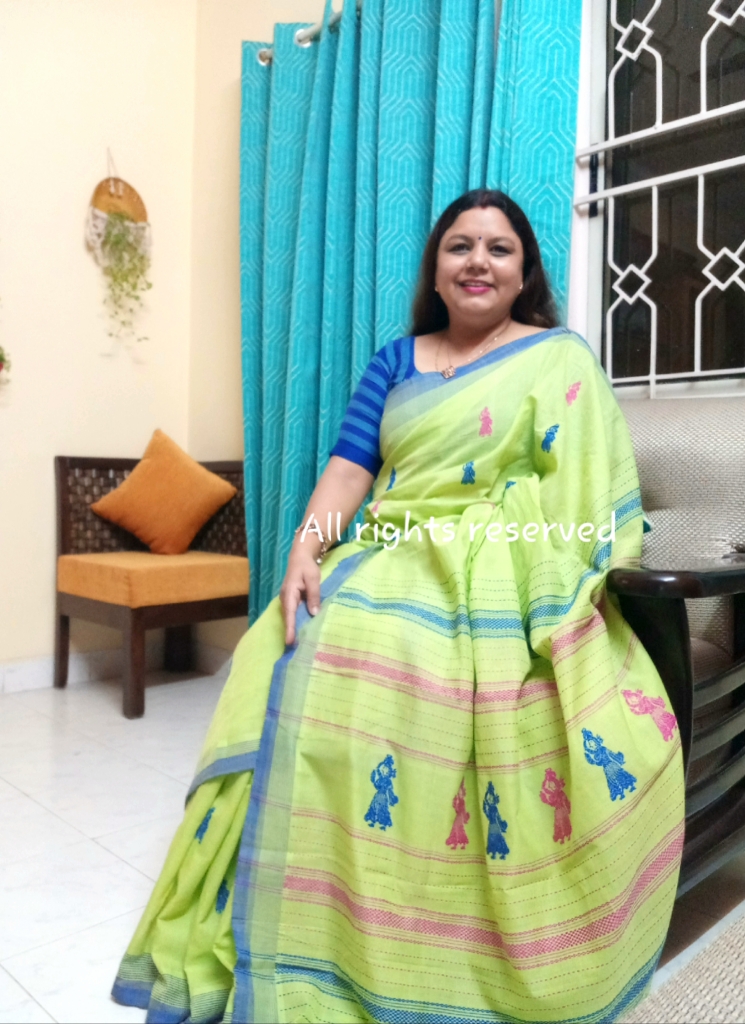
3. Kolattam Saree – The Siddipet sarees with Kolattam motifs express this rural dance form. Kolattam (Kol=stick, attam=dance), is a popular dance narrative in some of the states in Southern India. It is a combination of rhythmic movements, songs and music. The Kolattam comprises dancers grouped in pairs. The sticks provides the main rhythm (similar to Dandiya of Gujarat).

Mysore Silk: Mysore silk is produced by the Karnataka Silk Industries Corporation Limited (KSIC). The factory was founded in 1912 by Sri Nalvadi Krishnaraja Wodeyar, the Maharaja of Mysore. Initially, the silk fabrics were manufactured & supplied to meet the requirements of the royal family and ornamental fabrics to their armed forces. After India gained independence, the Mysore State Sericulture Dept. took control of the silk weaving factory. Mysore silk has also obtained a GI tag now. Here Kalyani Subramanyam, Program Director at The Naz Foundation India Trust flaunts a royal blue Mysore silk.
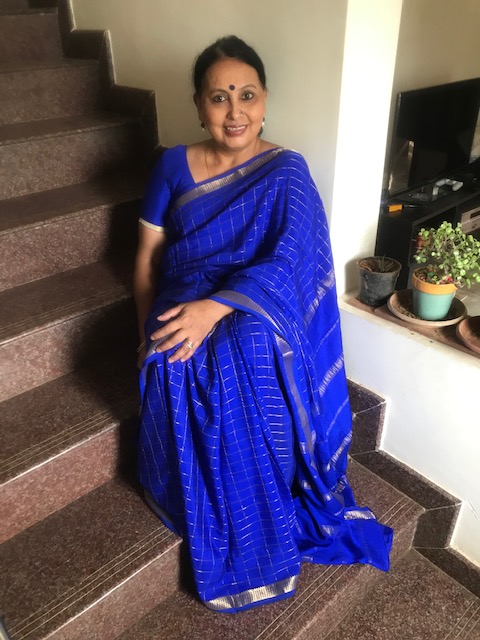
Telia Rumal: Woven in a flying shuttle loom in the intricate double ikat style, the telia rumal is a valuable craft that has been exported for centuries. The word telia (meaning oil) comes from the artisan’s distinctive use of castor ash and oil for colour retention. The word rumal (meaning handkerchief) is a nod to the square shape it was woven into for use as a headgear. It is a complex weaving technique, requiring immense skill, patience and time coming together to create a unique double Ikkat. The word Ikat comes from Malay Indonesian word Mangi Ikat for dyed knots before weaving Tell – oil and Rumal- kerchief. Oil to retain the color and kerchief for the square patterns. Here Lakshmi Srinath, known for her YouTube channel Lockdown Learnings flaunts her Telia Rumal saree.

Sambalpuri Pasapalli saree: This saree woven in pure silk . The Pasapalli saree derives its name from Chessboard (Pasa) checks like motifs seen on the borders of the saree along with rudrasksh motifs in extra warp.These are double bandha (tie) checks and hence the name double ikat or tie-dye The aanchal however is woven in intricate single bandha designs with rudraksh motifs in extra warp. Here Dr. Dhruti Bal, Sr Manager at Brittania Industries, wears a gorgeous Sambalpuri Pasapalli.

Mekhala Chador: Amidst the mesmerising tea gardens of Assam, you will surely find lovely Assamese women adorning the Mekhala Chador, as they go about the hustle and bustle of their day. Kautilya’s Arthashastra, a political literature of the 3rd century BC, gives us a glimpse of the history of silk and it’s close connection with Assam. Mekhala Chador is a two piece traditional Assamese drape, which has a unique style. Mekhala is the cylindrical skirt worn with a couple of pleats. The Chador is worn all around the body and tucked in with triangular folds. There are some popular weaving motifs on the ‘mekhela chadors’. The most commonly used are the khing-khap, (emblem), mogor (creeper ), mina (jewel), miri (tribal art) , gos (tree), jaapi ( bamboo hat), moyur (peacock), gor (rhino) and the gumkharu (traditional bracelet) designs. All in all, most of them are the artistic translation of everyday objects on the cloth or silk.The traditional silk mekhela chador has become very popular amongst the ‘saree – enthusiasts’ in the larger cities of the country. It is every such woman’s dream to own this for its sheer grace, elegance and exclusivity! Here is a happy Purnima Ashok, owner of Vivarjita creations in her Mekhala Chador.

Sickalnayakanpet Saree, Tamil Nadu: This is a Sikalnayakanpet saree that is a form of hand-painted saree made near Tanjore. It is believed that during the reign of Sevvappa Nayakar around 25 families were brought from Kalahasthi to decorate the palace and temple. These 25 families are well versed in almost all arts like drawing, block printing, batik, weaving, which in current times was extended to sarees too.

Dongria Kondh inspired sarees: The Dongria Kondh inspired Sarees are now woven by other weavers who are inspired by the tribe from the Eastern state of Orissa . The tribe in Niyamgiri Hills nurtures a deep reverence for their God Niyamraja, the forests , the streams & hills. Their life & every aspect of it is influenced by the eco-system of the hills. That it shows in their art & crafts like the colourful triangular embroidery seen on the Pallu of this Dongria Kondh Saree. It is an intricate part of Indian Handloom & a tribal masterpiece. The women of the Dongria Kondh tribe do the weaving, it is the most common piece of art produced in the community. They mostly weave Shawls & Sarees in vivid, bright colours & adorn them with a design of their Supreme Deity— Niyamraja, the God of the Mountains . The tribe lives secluded, hidden in the forests of the Niyamgiri range. So most of the weaving is done by hand.

These are but a few of the glorious weaves of our country which has many, many more. The next time we want to shop do think of the art and crafts of our country and make a choice that will help livelihoods, as also keep sustainable fashion in mind that uses natural materials.
Acknowledgements: I thank all the strong and wonderful women who contributed to the article!




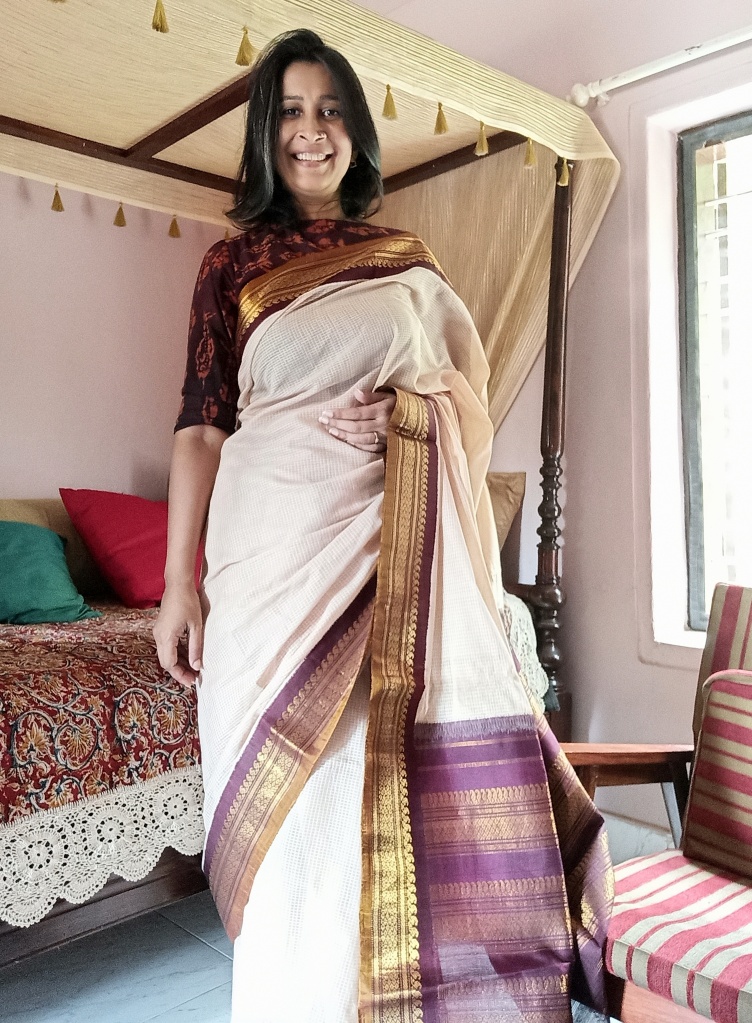



Such a wonderful tribute to handloom day, Sangeeta ! This is going to be a ready reckoner and will keep coming back to learn and appreciate our myriad weaves !
LikeLike
Thank you Sri for being part of it.
LikeLike
This is like a wiki of handloom weaves of India, Sangeeta. Such a wonderful compilation of iconic weaves in our country. Simply awesome..
LikeLike
Thank you for being part of this amazing journey.
LikeLike
A bouquet of beautiful weaves of India! A tribute to the weavers as we stand in solidarity with them on Handloom day. Very well articulated Sangeeta!
LikeLike
Thank you Lakshmi for being part of this !!
LikeLike
Amazing!! Wonderful compilation!! Kudos Sangeeta 🙌👏👍
LikeLike
Thank you Renu for being part of this!
LikeLike
This is gem collection of info, passionately composed and meticulously narrated, sabhash San..
Lovely treat of colourfully donned dames!!
LikeLike
This is such a wonderful post. All the information about the weaves in one place and sarees modelled by friends! Brilliant initiative. You always manage to capture our interest, Sangeeta and Kudos to you for that.
Wishing you a happy National Handloom Day. Saree on and keep blogging!
LikeLiked by 1 person
Thank you Vaishali!!
LikeLike
Such a wondeful post on weaves of India. It is always exciting for a woman to read any post on sarees as it has got that ever refreshing element for her in it.
Wow super collection of sarees with beautifully draped damsels. Here as Iam from Tamilnadu.. I got reminded of some of the special weaves… other than the KANCHEEPURAM ( of course the King of Weaves) like TRIBHUVANAM sarees known for their VISIRIMADIPPU…. Chinnalampattu sarees for their light weight and motifs…Sungadi Cotton sarees for their contrast border and bhutta combos…these regional weaves have not gained much popularity though they deserve to be. Just shared. KUDOS to that interesting blog. Keep exploring on many more weaves on and on…
LikeLike
Thank you for stopping by Shashikala and for your wonderful comment. Tamil Nadu has indeed some beautiful weaves as you mentioned. I have also mentioned Koorainadu in the list – and an article written by me was published in the Deccan Herald. (the link available in my blog too). I will indeed write about more weaves and perhaps go statewise. Do click on the follow button or subscribe to the blog for automatic notifications!
LikeLike
Wonderful Sangeeta. Looking forward to Part 2 with many more weaves.
LikeLiked by 1 person
Thank you Sujatha! Please do spread the word about the blog so that people can subscribe to it. Am planning a lot to be shared!
LikeLiked by 1 person
Wonderful article. Liked all the sarees and the models.
LikeLiked by 1 person
Thank you Nitya!
LikeLiked by 1 person
Pingback: Guest Blog: Thoughts on World Saree Day- December 21st | sojourn-with-san